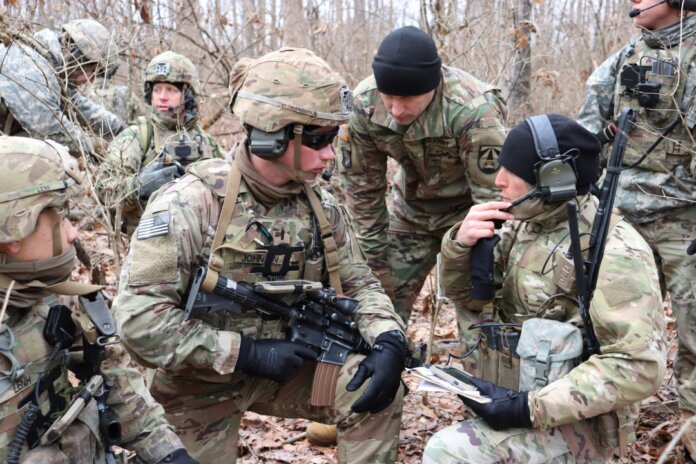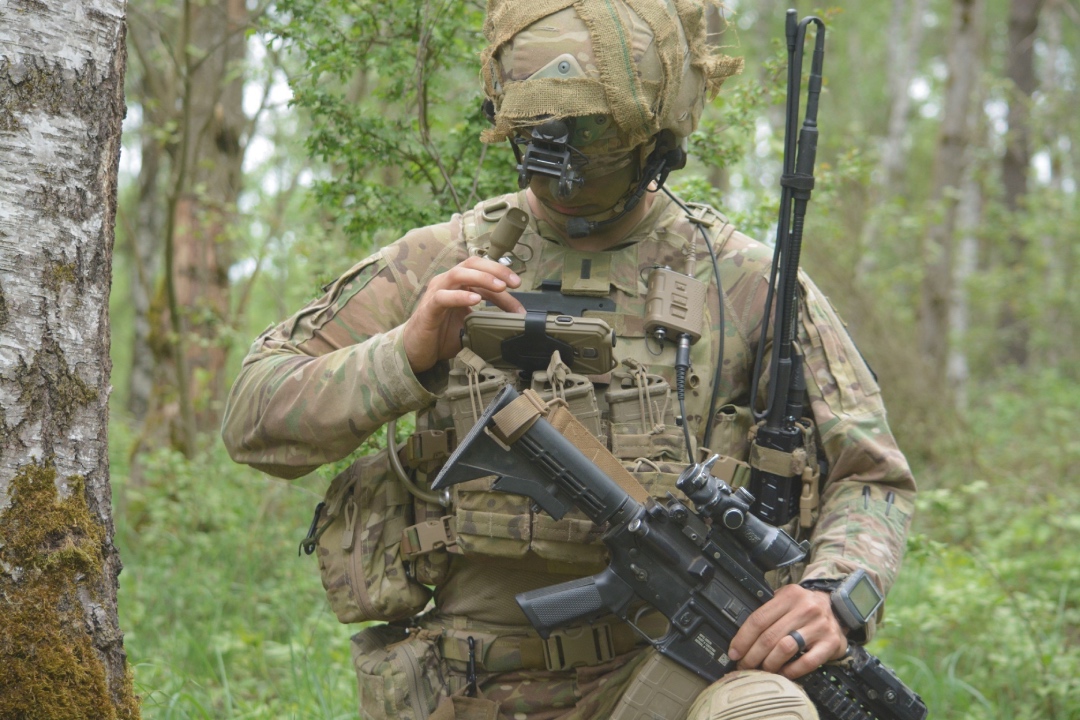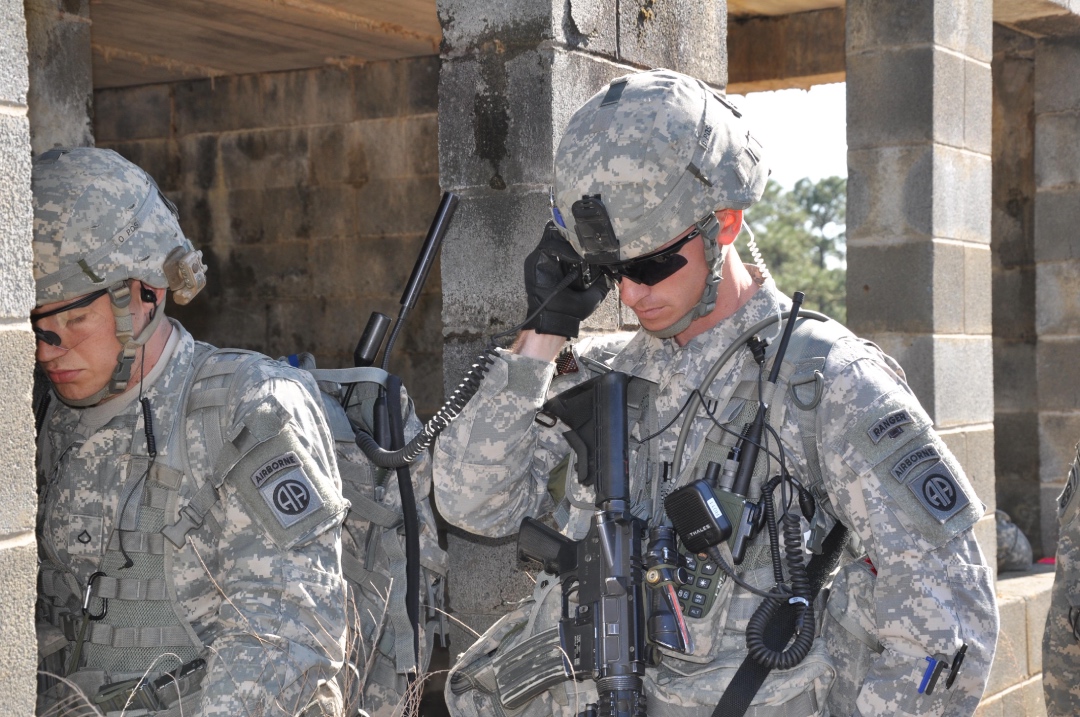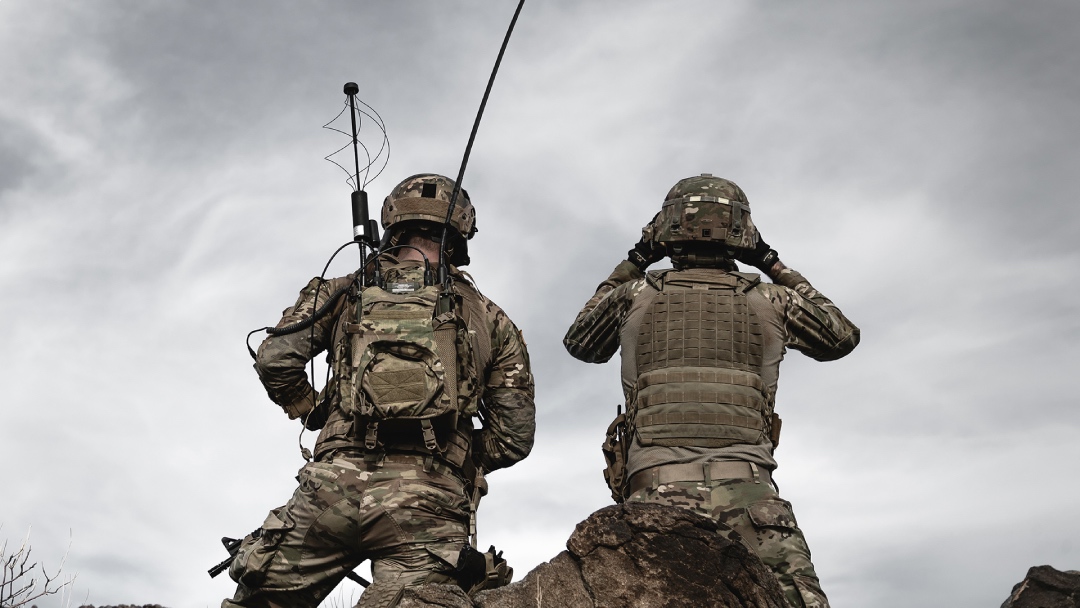
The introduction of Integrated Tactical Networks will deliver a step-change in the way data and communications is available over the battlefield.
The global access to, and sharing of, data and information is growing at an exponential rate. Within the military, this is having significant implications. Always information intense, their problem has often been in getting the information gathered to those that can best use it. This is particularly a concern with ground forces at brigade level and below.
Information and electronics technologies available now and in development are not only changing the very way in how future battles may be fought, but also how a range of activities from supply to maintenance are practiced. In fact, many of the latest weapons, sensors, and other equipment using digital architecture can already share data. The challenge is capitalising on these by expanding the capability to broadly exchange this information.
The US Army’s Integrated Tactical Network (ITN) seeks to do exactly that. The premise is that sharing data quickly increases real-time situational awareness not only of friendly but also enemy forces, as well as a myriad of other support, logistics and readiness aspects. Accomplishing this requires networking a range of divergent information gathering and communications systems.
The primary objective of the ITN is to provide a reliable flow of information accessible to various parties. One focus has been to provide targeting information by making battlefield observations of multiple sensors directly available to tactical units. It directly enables what US Army Major General Ross Coffman, director Next Generation Combat Vehicles Cross Functional Team, refers to as a “connected battlefield” that allows engagement “from any sensor to the best shooter.” But the benefits extend beyond fighting. Being able to exchange the usage and maintenance status of individual vehicles and equipment from their own onboard health monitor systems offers unprecedented awareness of force readiness. Knowing the force status allows for commanders to anticipate and proactively correct impending failures. Similarly, with logistics commanders able to monitor ammunition and other supply usage in near real-time, they would then anticipate the needs of forward units and advance resupply precluding any shortfall that could affect each unit’s combat power. Harnessing the interconnectivity of these diverse digital medium offers new possibilities in military operations virtually across the board.

Purpose of ITN
The objective of an ITN is the seamless connection of all levels of the military force in a manner which allows dynamic and secure communication between its participants. This itself is not new, although the idea of expanding the access to information available within participants covered by the network has not previously been possible. As Brigadier General Jeth Rey, director of the Army’s Network Cross Functional Team, outlined: “Currently, our network centric environment is just [the commander] going to reach for data when he thinks he needs it. We want a data centric environment to produce information for the commander to make informed decisions.”
The focus of ITN is providing manoeuvre brigades and below with smaller, lighter, faster, and more flexible communications systems. It is intended to allow unit leaders to not only readily pass and receive information with their command chain, but for them to monitor their own unit and surroundings in real-time. It makes it possible for the forward soldier to access observations and information from sensors that may be operating in their area of interest, expanding the soldier’s awareness of the immediate surroundings. Whereas traditional communications were vertical up and down the chain of command, with ITN it is also possible to exchange and access information laterally. In addition, it capitalises on the benefits of digital architectures. As Mikko Karppinen senior vice president, Mission Capability at Finland’s Patria defence company explained, “the transition from analog based systems to digital enables various new ways of interacting and handling of transmitted and collected data compared to analog systems. It is possible to automate processes rapidly, refine data faster and create complex workflows by utilising digitalised information. This leads to a more accurate and up to date common operational picture and situational awareness.” Being able to pass more data faster using digital is an efficiency multiplier in every application.
The US Army is taking a novel approach to building its ITN. Colonel Garthe Winterle program manager Tactical Radios shared that “ITN it is not a new network but rather incorporates the current tactical network environment with commercial-off-the-shelf (COTS) components and transport capabilities. It is being developed and fielded in increments – starting with dismounted infantry, then Stryker units (which have a mix of mounted and dismounted needs), and then armoured units. As each increment is fielded the next is being developed, building on results of the previous.”
Maj Gen Thomas Pugh, the director of Networks, Services and Strategy for the Army’s Deputy Chief of Staff, G-6, explained: “The US Army is staffing an implementation plan focusing on what can be done in 2022 and 2023 to begin integrating the enterprise network and then making the unified network operational by 2025.” This is being done incrementally each two years by developing, testing, and fielding ITN advances through capability sets.
Capability Sets (CS) Defined
“As a capability set is fielded, development of the next is underway with objective of incorporating lessons learned, defining new requirements, and incorporating promising technologies along the way,” explained Lieutenant Colonel Jon Judy, project manager Capability Set Development.
CS2, the first iteration of ITN, includes enhanced satellite communications (SATCOM) capability over existing terminals and initial on-site cloud (edge) agile computing. These are provided through new data radios, mission command applications and hardware, and more expeditionary satellite communications terminals and associated hardware. The reliance on selected commercial solutions integrated with existing fielded hardware helps to accelerate its introduction into service. Initial Capability Set 21 (CS21) was provided in 2021 to four Infantry Brigade Combat Teams with five additional units programmed for 2022.
The Network CFT defined Capability Set 23 (CS23) increases the bandwidth available within the ITN to support sensor data, graphics, and video. It also expands communication routes capitalising on commercial low-earth and mid-earth orbit (LEO/MEO) satellites and introduces mesh networking to allow extending the range and ability of the network to support manoeuvre. Its stated application of the ‘tactical cloud’ will result in ‘converged mission applications, integrated intelligence, and an enhanced common operating picture (to) ensure usable information supports warfighter decision-making.” A further goal is to reduce susceptibility to jamming and decrease vulnerabilities. A primary focus is appropriately configuring the ITN for Stryker Brigade Combat Team operations entailing high mobility and tactical tempo, as well as configuring for mounted vehicle usage.
Capability Set 25 (CS25)’s objectives include expanded application of the tactical cloud including the introduction of artificial intelligence to aid decision-making. It also seeks to incorporate variants of commercial 5G to formations for faster conductivity. A major focus will be on facilitating data networking between ground and aviation. CS25 will begin introduction to service the needs of the armoured brigade combat teams. The following Capability Set 27 (CS27) intends to build on this by exploring non-traditional waveforms, expanding artificial intelligence and machine learning tools, hardening 5G-like capabilities, and perfecting ‘full and seamless integration of applications and systems…improving interoperability, information sharing, and accelerated decision making.’

ITN Elements & Equipment
Achieving the demands of an ITN for the next battlefield requires new digital equipment that, unlike previous legacy systems, can operate across a number of frequency bands. Where previously separate radios were needed for VHF (mostly used for voice ground-to-ground) and UHF (typically used by aircraft), these have both. They are also compatible with satellite, data transmission, video, and Beyond-Line-Of-Site (BLOS) communication. These new systems allow not only voice and data but allow video feed. Where much of this capability such a multi-band software enabled tactical radios had been previous Programmes of Record (PoR), ITN weaves them more closely. It also makes use of commercial devices like the Samsung End-User Device (EUD) with the Army NETT Warrior.
LTC Judy explained that PoR radios being fielded are the core of ITN and a focus in Capability Set 21. The latest leader radios (LR) are for small unit use. These include the AN/PRC-163 from L3Harris and AN/PRC-148 Thales Défense. Both are digital dual-channel, multi-mission software defined that offer UHF/VHF, SATCOM, or Mobile Ad-Hoc Networking (MANET) with ISR video and GPS. These handheld ‘team’ radios are around 2.2 pounds (1 kilogramme). These squad/team radios are complemented by digital Manpack radios; the AN/PRC158 from L3Harris and AN/PRC-162 by Collins Aerospace. These offer two channels with simultaneous transmission and reception of voice and data. They can manpack with 20 Watt peak power or 50W with vehicle power amplifiers. They operate in frequencies from 30MHz to 1850MHz encompassing narrow band VHF and UHF, SATCOM, MUOS, and wide band UHF and L-Band and have embedded encryption. Equally important is that they are compatible with SINCGARS, HAVEQUICK, and other legacy radios.

Additional systems in the initial ITN contained in CS21which have been identified in field evaluations include its Android Tactical Assault Kit (ATAK), a government developed map-based application applied to a Samsung handheld end-user device (EUD), essentially a militarised cell phone or tablet. ATAK provides real-time Position Information Location (PIL) covering terrain and troop locations. The device enhances situational awareness and unit coordination including tracking friendly forces, navigation, chat, and information exchange including video streaming. It can substitute for a number of dedicated devices as well as interfacing with other battlefield applications. Beyond planning and tactical employment ATAK has proved invaluable in unit sustainment efforts.

Providing reliable communications to not only the unit leaders but to every frontline soldier is a key concern. Col Winterle explained: “Not only are weight, size, and simple operation essential but so is price if is to be widely distributed.” A limited number of L3Harris’s AN/PRC-171 Line-of-Sight Compact Team radios with voice and data modes (compatible with the PRC-163) have been acquired for consideration. Another possibility being evaluated is the MPU5 Networked Radio by Persistent Systems. Already used by the British Royal Marines, it utilises wave relay mobile ad-hoc (MANET) technology with integrated Radio Voice over IP capability and Cloud Relay to provide coverage in a compact 13 ounce (368 gramme) L-band radio.
The MUOS (Mobile User Objective System) capability originally developed by Lockheed-Martin for the US Navy has also been favourably received. Corporate litrature explains; ‘MUOS offers tactical terminals seamless connection to satellite supported voice, video, and mission data on a high-speed Internet Protocol-based system.’ It provides ten times the capacity of current UHF SATCOM. Col Winterle explained that MUOS in its improved Gen 2 configuration is relied on for medium to long range non-line-of-sight (NLOS) communication and is proving itself with US forces in Europe.
Secure but Unclassified
Secure But Unclassified (SBU) architecture is a key feature of ITN. This shift from a classified network to SBU opened the possibility for not only employing commercial products but enhanced the amount of data that could be moved. It permits leverage of cellular such as 4G, LTE and WiFi permitting tools like video streaming. Another associated but critical aspect in ITN is the ability to access a ‘Cloud’ data base. Like a commercial Cloud, data would be centrally stored and therefore be available to users as needed. The structure of this “tactical Cloud” is a “work in progress”, commented Col Winterle.
Another innovation offered in ITN is the Tactical Scalable Ad-hoc Network (TSM). It allows the establishment of an interconnected, mutually supporting mesh network communications ‘bubble’. It employs commercial waveforms, such as the TrellisWare Technolgies’ (TSM) and Warrior Robust Enhanced Networking (WREN), to tie together the tactical radios of units. A mesh network allows expanding its coverage and reach, as each device (node) shares its connection with the larger network. With TSM, even if one device can only directly access one other device it can, through that connect, still link to other devices within the network. The Mesh network is also ‘self-healing’, meaning if one link is lost a device automatically seeks new alternate connections. Use of wireless mesh networks are common in commercial and public Wi-Fi applications. The Army’s inclusion of variable height antenna further enhances the possibilities of the TSM. Another facilitator being actively evaluated is the use of Unmanned Aerial Systems (UAS), both longer range and locally launched, to act as retransmission assets.

Field Experience
CS21 is reaching field units so end-user field experience on its capabilities, benefits and current shortfalls is now being generated. In an after-exercise briefing, LTC Andy Harris Commanding the 1st Battalion, 504th Infantry (Airborne) stated: “ITN offers 100 percent improvement…it offers visual confirmation of where your units are in space and time. You’re pulling real-time data.” The 3d IBCT, 25th Infantry Division in Hawaii also have experience with ITN. Considering the extended distances of the Indo-Pacific area, Col Josh Bookout, the 3/25 commander, explained: “the Manpack Mobile Objective System (MUOS) Tactical Satellite radio was a great capability. We are capable of TACSAT (tactical satellite) communications down to company and troop level. That becomes a game changer.”
Unsurprisingly, given the rapid fielding, some concerns were also identified. Cables linking the various devices were determined to be overly complex and, particularly those carried by the individual soldier, heavy and awkward when wearing body armour and equipment. Another concern was the tendency for squad members to focus on the EUD rather than being heads-up watching their surroundings. LTC Judy noted that “it was recognised early on that building the ITN would be an iterative process. The object is to take lessons learned from each fielding and apply them to continuously improve it and address highlighted issues.”
LTC Judy also identified a major issue has been training: “The rapid fielding has not allowed the training structure to keep-up. An aspect of this is that ITN’s IP based radios require specific planning to operate together. Recognising this, the intent is to provide broader training support with Capability Set fielding.
Next Steps
Even as CS21 is issued to active army infantry units, the components of CS2023 are being identified, refined, and incorporated into the projected package. LTC Judy shared that “a Critical Design Review (CDR) should occur in April 2022 to approve its direction and finalise the composition.” CS23 will go to the 2d Cavalry Regiment equipped with Stryker combat vehicles. Judy added “that the 2d Cav has an earlier version of Stryker which would increase the integration challenges particularly regarding available on-board power. However, the benefit is that successfully integrating on this version better assures it can be done on the latest DVH A1 models.” That Stryker units tactically mix both mounted and dismounted operations, also offers a bridge between adapting the infantry focused ITN and the future armour ITN. Aspects to be addressed include on-the-move operations, transitioning from mounted to dismounted, providing mobile command posts, building a common operating picture for the force, and enhancing situational awareness in a high manoeuvre environment. CS2023 is targeted to be introduced as early as January 2023.
The impact of introducing the capabilities offered in ITN are only beginning to be realised. How it may alter tactics will become evident only from hands-on operations in the field.
by Stephen W. Miller













